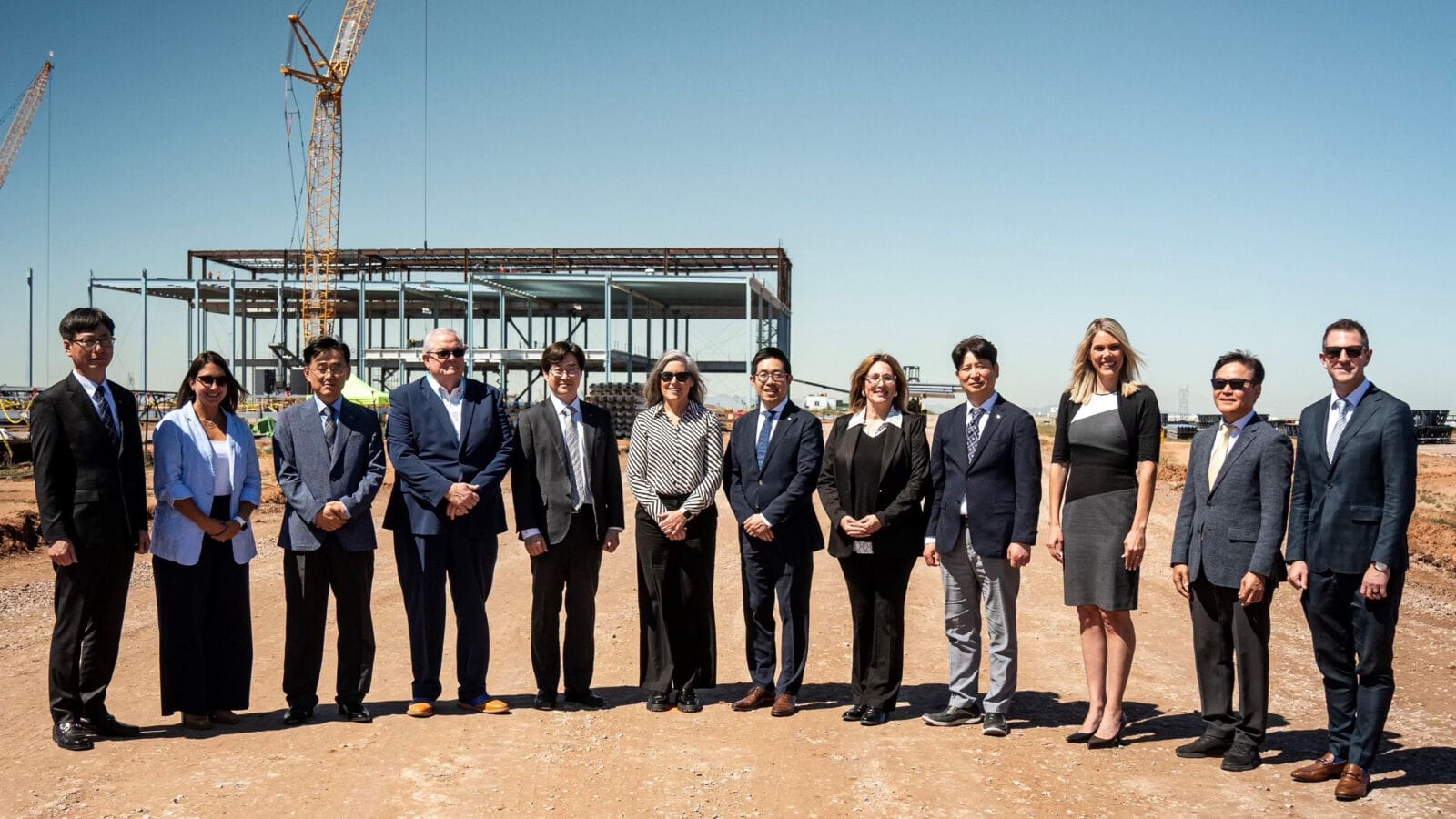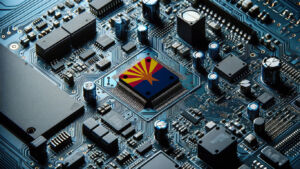The construction of a major battery manufacturing complex in Queen Creek, Arizona, announced by LG Energy Solution last year, is on track to be completed in two years with the first round of hiring expected to begin at the end of this year. The company provided progress updates on its $5.5 billion stand-alone facility during a stakeholder meeting today at Combs High School in San Tan Valley near the complex location.
MORE NEWS: Construction begins on Camelback 303 Logistics Center
The attendees included Governor Katie Hobbs; Richard Ra, President of LG Energy Solution Arizona; Brian Oh, Head of Mobility & IT Battery Division at LG Energy Solution; Hyung Kim, Head of ESS Battery Division at LG Energy Solution; Sandra Watson, President and CEO of the Arizona Commerce Authority; Queen Creek Mayor Julia Wheatley; Mike Goodman, Supervisor, District 2 and Chairman of the Pinal County Board of Supervisors, and project partners.
“This transformative investment will have a lasting impact not only in Arizona, but across the country and moves us one step closer toward our clean energy goals,” said Governor Katie Hobbs. “These are the jobs of the future – and the State of Arizona is committed to being an active partner in ensuring Arizonans have the skills to fill these jobs.”
During the event, Governor Hobbs announced the creation of a new battery-focused Future48 Workforce Accelerator to be located in Apache Junction in partnership with Pinal County, Central Arizona College, LG Energy Solution, the Arizona Commerce Authority and McCarthy Construction.
The complex consists of two manufacturing facilities which are the company’s first stand-alone cylindrical and ESS battery plants in North America. The cylindrical battery plant, called LG Energy Solution Arizona, will produce 46-Series batteries for electric vehicles (EV). A crucial part of the company’s innovative product portfolio, 46-Series cylindrical batteries demonstrate LG Energy Solution’s advanced technological leadership throughout various applications for EVs. As the company plans the first mass production of 46-Series batteries at its Ochang plant in Korea in the second half of this year, which is the earliest among major global battery manufacturers, LG Energy Solution Arizona is expected to continue the momentum and reinforce the manufacturing capability.

The ESS battery manufacturing facility, called LG Energy Solution Arizona ESS, will produce lithium iron phosphate (LFP) pouch-type batteries for energy storage systems (ESS). It is one of the first ESS-exclusive battery production facilities in the world. By situating its stand-alone ESS battery facility in North America, the world’s biggest ESS market, LG Energy Solution aims for a timely response to the fast-growing needs for locally manufactured batteries on the back of the U.S. clean energy policies, providing ESS batteries with enhanced competitiveness in cost, battery life, and safety.
When fully operational, the complex’s average annual production capacity is expected to reach 53GWh (cylindrical batteries 36GWh, LFP ESS batteries 17GWh).
During the construction progress updates and site tour, Richard Ra, President of LG Energy Solution Arizona, said the project has been well underway since the groundbreaking last November, with initial land preparations completed and steel beams now being placed at the site. With the construction going as planned, the manufacturing facility for cylindrical EV batteries is expected to be completed in late 2025, and the facility for LFP pouch-type ESS batteries in the following year.
Once the construction is complete, both facilities are expected to start production in 2026. To secure a high-quality workforce that will operate the state-of-the-art manufacturing complex, the company will also commit to hiring and fostering the next-generation battery professionals in the area, creating several thousand new quality jobs. “We expect the recruitment of our (launch team) members to begin late this year, and a full-scale recruitment to follow from the second half of 2025,” said Ra.
“By further expanding our product portfolio and offering diverse options to our customers, we will continue to strengthen our market competitiveness”, said David Kim, CEO of LG Energy Solution. “We also expect to keep growing in the global market by maximizing customer value through unmatched technology leadership.”
“Of many other sites, this Arizona facility has a special meaning to us. This is the second stand-alone facility to be built in the U.S. and it is also the first manufacturing facility to produce cylindrical batteries in the U.S. Right here, is where we can build quality cylindrical batteries, which will be used to power millions of EVs,” said Brian Oh, Head of Mobility & IT Battery Division at LG Energy Solution. “It gives me great pleasure, knowing that this landmark project, here in Queen Creek will create thousands of new, quality-jobs that will contribute to building a green economy.”
“ESS plays a vital role in green energy infrastructure as it utilizes power supply in a flexible manner,” said Hyung Kim, Head of ESS Battery Division. “There is no better place to build the source of our sustainable energy here in Arizona, where the abundant solar energy surrounds the region. Quality batteries made right here in the Copper State will reach every corner of America to provide power.”
“LG Energy Solution’s new facility, which represents one of the most significant green energy projects anywhere in the country, will anchor Arizona’s growing battery manufacturing industry while creating thousands of new jobs,” said Sandra Watson, President and CEO of the Arizona Commerce Authority. “We are grateful to LGES Arizona President Richard Ra and the entire team at LG Energy Solution for their continued commitment to Arizona and look forward to continue supporting this exciting project, including through the establishment of a new Future48 Workforce Accelerator.”
“It is so exciting to see this monumental project continue to move forward,” said Queen Creek Mayor Julia Wheatley. “The substantial investment will create a positive ripple effect for the region and the state, bringing local jobs, infrastructure, and capital investment. LGES is paving the way for our advanced manufacturing corridor – we are so excited to welcome them to the community. We value their partnership and appreciate the coordination from the county and state.”
“As a county, we see around 80% of our residents drive into other counties every day for work,” said Mike Goodman, Supervisor-District 2 and Chairman of the Pinal County Board of Supervisors. “So it has always been a priority for myself and my fellow Supervisors to address this by bringing high-quality jobs to Pinal County, and we’re delighted LGES’ investment is a significant step towards this goal.”
LG Energy Solution has another stand-alone facility in Michigan, which was built a decade ago and is currently undergoing expansion that would quintuple its average annual production capacity. The company also has five other joint venture facilities in the U.S. with major automakers, including General Motors, Honda, and Hyundai Motors Group, representing its full-fledged efforts to provide IRA-compliant batteries that will expedite the clean energy transition in the country.
With the Arizona complex, the company has now secured the most diverse and competitive product portfolio, which encompasses pouch-type and cylindrical batteries for EVs and LFP batteries for ESS, in North America.




